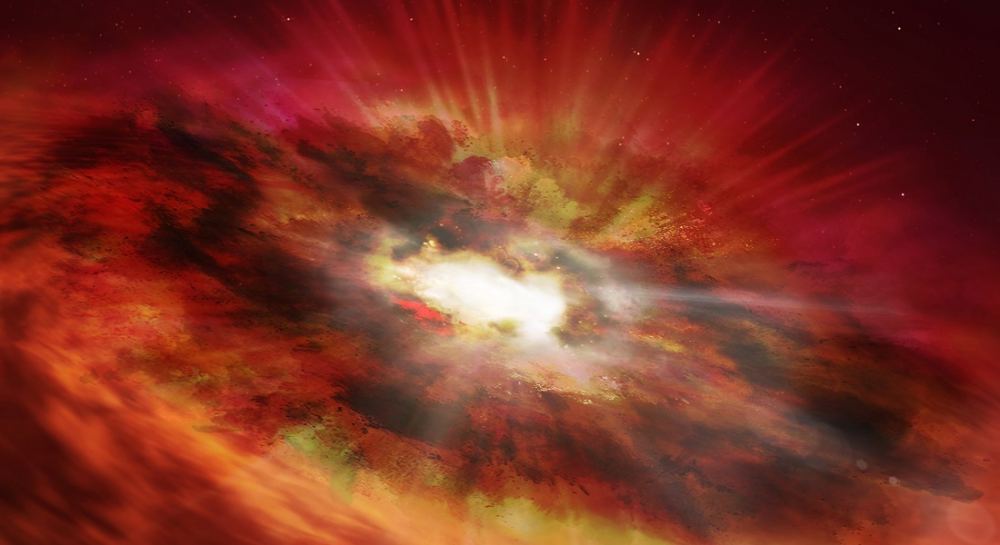Supermassive black holes haunt the cores of many galaxies. Yet for all we know about black holes (not nearly enough!), the big ones remain a mystery, particularly when they began forming. Interestingly, astronomers see them in the early epochs of cosmic history. That raises the question: how did they get so big when the Universe was still just a baby?
A team of astronomers in Taiwan is looking for answers. Led by Chi-Hong Lin and Ke-Jung Chen from Academia Sinica and Chorng-Yuan Hwang of National Central University, the team is researching formation theories for supermassive black holes (SMBH). They’ve used sophisticated models of galaxy mergers to take a peek at the formation of these monsters and included giant molecular clouds as part of the process. “Our research results can offer people a deeper understanding of galaxy evolution,” Lin said. “We anticipate that there will be more observational results to verify our conclusion.”
Giant Molecular Clouds and SMBH
The team suggests that the growth of black holes in early galaxies primarily occurs through the accretion of those molecular clouds during mergers. Thanks to the gravitational forces at work these massive clouds fall to the galactic center very efficiently. That increases the formation rate of stars in the galaxy and provides the building blocks for the rapid growth of a central SMBH.
The idea of collapsing molecular clouds is not a new one. Earlier papers suggested the idea, but this work models their quick growth. It shows that black holes of a few million solar masses can grow to billions of solar masses within a few hundred million years. That helps explain why we see SMBH so early in cosmic history.
Supermassive Black Holes and Mergers
Understanding the formation of SMBH in galaxy cores is one of astronomy’s challenges. These monsters can grow to contain millions or billions of solar masses. And, you might be forgiven if you assume that something that massive would take billions of years to form. After all, a galaxy needs at least that much mass—and a lot more—to sustain such a monster at its heart. Mergers of galaxies take place on timescales that range up to millions of years.

For example, the galaxies in the Mice collision (above) are partway through their merger. The Milky Way and Andromeda are in the earliest stages of a collision that will take perhaps 7 or 8 billion years to complete. Their central black holes will merge, too.
Astronomers have known since the late 1960s that most galaxies have SMBH in their cores and that they’re somehow associated with their host galaxies. Research seems to correlate the mass of the black hole to a galaxy’s bulge, stellar mass, and other characteristics. Further research also suggested that it took time for all this accretion to a black hole to take place.
So, imagine everyone’s surprise when they started finding them in galaxies lying more than 12 billion light-years away. That puts them at a time in cosmic history when the Universe was not quite a billion years old. How could this happen? That’s where the simulations of massive clouds of gas in galaxies come into play.
Invoking New Models of Supermassive Black Hole Formation
The team in Taiwan created simulations of merging galaxies in an effort to explain the rapid growth of SMBH in the early Universe. They had to take into account different kinds of mergers, including gas-rich and gas-poor galaxies and minor mergers. They also took into account those giant molecular clouds and the role they play during a merger.
The clouds present an interesting problem. First, they’re involved in higher star-formation rates during a merger, and at least half (if not more) of that star-birth activity takes place in the core regions. In gas-poor galaxies, there’s still star formation (although not as much as in a gas-rich merger) and it’s also accelerated at the core. Star formation obviously contributes to the mass of a galaxy’s bulge. One with a massive bulge will likely experience many minor mergers during the growth phase of the galaxy.
The second thing about these massive gas clouds is that they have a lot of kinetic energy. But, they lose that energy during a merger, thanks to dynamical friction. That makes them fall into the center of the galaxy fairly quickly. There, they get involved in star formation and the creation and growth of a future SMBH. In their paper, the team notes that once a black hole formation scenario starts during a merger, it can grow from a hundred million solar masses to over a billion solar masses in just 300 million years.
Implications for the Milky Way and Beyond
Our own Milky Way is a merger baby. It continues merging with other smaller dwarf spheroidals even today. And, its future merger with Andromeda will change its shape once again. It’s very likely that giant molecular clouds played a role in the Milky Way’s evolution. The team actually investigated this possibility by examining the impact of a minor merger on a Milky Way-like galaxy. The simulation showed that the size and mass of that theoretical galaxy’s bulge almost doubled. Interestingly, they concluded that the Milky Way has not yet experienced any major mergers—but plenty of minor ones. That will change as the Andromeda collision proceeds over the next few billion years.

New surveys of the Universe over the next few years conducted by JWST and the Vera C. Rubin Observatory will provide a lot more data for ongoing modeling and simulation of galaxy mergers. That should shed new light on the growth of supermassive black holes at the hearts of early merging galaxies.
For More Information
Unveiling the Rapid Growth of Supermassive Black Holes
Rapid Growth of Galactic Supermassive Black Holes through Accreting Giant Molecular Clouds during Major Mergers of Their Host Galaxies

